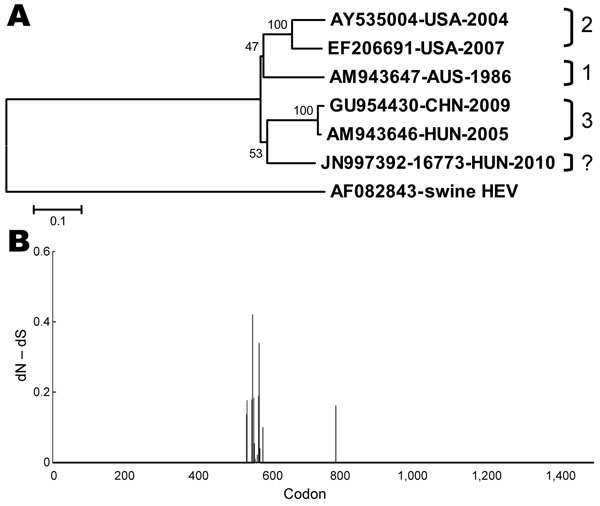Volume 18, Number 8—August 2012
Dispatch
Putative Novel Genotype of Avian Hepatitis E Virus, Hungary, 2010
Figure

Figure. . . . Genomic structure of HUN-16773-2010 and 5 other avian hepatitis E virus (aHEV) strains. A) Neighbor-joining tree constructed from the nucleotide sequences (14) of the nearly complete genome of 6 aHEV strains. Bootstrap values are indicated at branch nodes. A swine HEV served as outgroup in the phylogeny. Genotype assignments are depicted for reference aHEV genomes. Scale bar indicates genetic distance. B) Adaptive evolution of aHEV genomes. Only sites under positive selection in open reading frame 1 are shown with normalized value of dN – dS along the codon positions, as indicated by the random effects likelihood method and by using the default significance level (www.datamonkey.org).
References
- Meng XJ. Hepatitis E virus: animal reservoirs and zoonotic risk. Vet Microbiol. 2010;140:256–65. DOIPubMedGoogle Scholar
- Payne CJ, Ellis TM, Plant SL, Gregory AR, Wilcox GE. Sequence data suggests big liver and spleen disease virus (BLSV) is genetically related to hepatitis E virus. Vet Microbiol. 1999;68:119–25. DOIPubMedGoogle Scholar
- Haqshenas G, Shivaprasad HL, Woolcock PR, Read DH, Meng XJ. Genetic identification and characterization of a novel virus related to human hepatitis E virus from chickens with hepatitis-splenomegaly syndrome in the United States. J Gen Virol. 2001;82:2449–62.PubMedGoogle Scholar
- Morrow CJ, Samu G, Mátrai E, Klausz A, Wood AM, Richter S, Avian hepatitis E virus infection and possible associated clinical disease in broiler breeder flocks in Hungary. Avian Pathol. 2008;37:527–35. DOIPubMedGoogle Scholar
- Ivanics É, Benyeda Z, Benyeda J, Nagy G, Dán Á, Tóth Á, Examination of hepatitis-E virus induced disease in Hungarian laying hen flocks [in Hungarian]. Magy Allatorv Lapja. 2011;133:587–93.
- Bilic I, Jaskulska B, Basic A, Morrow CJ, Hess M. Sequence analysis and comparison of avian hepatitis E viruses from Australia and Europe indicate the existence of different genotypes. J Gen Virol. 2009;90:863–73. DOIPubMedGoogle Scholar
- Johne R, Plenge-Bönig A, Hess M, Ulrich RG, Reetz J, Schielke A. Detection of a novel hepatitis E–like virus in faeces of wild rats using a nested broad-spectrum RT-PCR. J Gen Virol. 2010;91:750–8. DOIPubMedGoogle Scholar
- Billam P, Sun ZF, Meng XJ. Analysis of the complete genomic sequence of an apparently avirulent strain of avian hepatitis E virus (avian HEV) identified major genetic differences compared with the prototype pathogenic strain of avian HEV. J Gen Virol. 2007;88:1538–44. DOIPubMedGoogle Scholar
- Huang FF, Sun ZF, Emerson SU, Purcell RH, Shivaprasad HL, Pierson FW, Determination and analysis of the complete genomic sequence of avian hepatitis E virus (avian HEV) and attempts to infect rhesus monkeys with avian HEV. J Gen Virol. 2004;85:1609–18. DOIPubMedGoogle Scholar
- Zhao Q, Zhou EM, Dong SW, Qiu HK, Zhang L, Hu SB, Analysis of avian hepatitis E virus from chickens, China. Emerg Infect Dis. 2010;16:1469–72. DOIPubMedGoogle Scholar
- Marek A, Bilic I, Prokofieva I, Hess M. Phylogenetic analysis of avian hepatitis E virus samples from European and Australian chicken flocks supports the existence of a different genus within the Hepeviridae comprising at least three different genotypes. Vet Microbiol. 2010;145:54–61. DOIPubMedGoogle Scholar
- Koonin EV, Gorbalenya AE, Purdy MA, Rozanov MN, Reyes GR, Bradley DW. Computer-assisted assignment of functional domains in the nonstructural polyprotein of hepatitis E virus: delineation of an additional group of positive-strand RNA plant and animal viruses. Proc Natl Acad Sci U S A. 1992;89:8259–63. DOIPubMedGoogle Scholar
- Martin DP, Lemey P, Lott M, Moulton V, Posada D, Lefeuvre P. RDP3: a flexible and fast computer program for analyzing recombination. Bioinformatics. 2010;26:2462–3. DOIPubMedGoogle Scholar
- Tamura K, Peterson D, Peterson N, Stecher G, Nei M, Kumar S. MEGA5: Molecular Evolutionary Genetics Analysis using maximum likelihood, evolutionary distance, and maximum parsimony methods. Mol Biol Evol. 2011;28:2731–9. DOIPubMedGoogle Scholar
- Pudupakam RS, Kenney SP, Córdoba L, Huang YW, Dryman BA, Leroith T, Mutational analysis of the hypervariable region of hepatitis E virus reveals its involvement in the efficiency of viral RNA replication. J Virol. 2011;85:10031–40. DOIPubMedGoogle Scholar
Page created: June 28, 2012
Page updated: June 28, 2012
Page reviewed: June 28, 2012
The conclusions, findings, and opinions expressed by authors contributing to this journal do not necessarily reflect the official position of the U.S. Department of Health and Human Services, the Public Health Service, the Centers for Disease Control and Prevention, or the authors' affiliated institutions. Use of trade names is for identification only and does not imply endorsement by any of the groups named above.